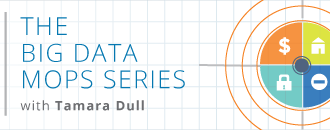Platfora has gained a lot of buzz in the Big Data analytics market primarily through word of mouth. Late last year the company took the covers off of some impressive and potentially disruptive technology that takes aim at the broad BI and business analytics ecosystem, including the very foundation on which the industry is built. It recently demonstrated its software at the Strata Conference where the audience that is fixated on big data was in attendance.
Platfora has gained a lot of buzz in the Big Data analytics market primarily through word of mouth. Late last year the company took the covers off of some impressive and potentially disruptive technology that takes aim at the broad BI and business analytics ecosystem, including the very foundation on which the industry is built. It recently demonstrated its software at the Strata Conference where the audience that is fixated on big data was in attendance.
Platfora looks to provide the underlying architecture of tomorrow’s  BI systems and address the challenge of big data analytics. Our benchmark research shows that one of the biggest hurdles facing next-generation BI systems is usability and was the top category in 63 percent of organizations. This is of specific concern when it comes to big data analytics and today’s Hadoop ecosystem, where many companies are taking to the Field of Dreams approach – if you build it, they will come. That is, many companies are setting up Hadoop clusters, but users have no access to the underlying data and need data scientists to come in and painstakingly extract nuggets of value. Simply connecting Hadoop to applications via connectors does not work well since there is no good way to sort through the Hadoop data to decide what to move into a more production-oriented system.
BI systems and address the challenge of big data analytics. Our benchmark research shows that one of the biggest hurdles facing next-generation BI systems is usability and was the top category in 63 percent of organizations. This is of specific concern when it comes to big data analytics and today’s Hadoop ecosystem, where many companies are taking to the Field of Dreams approach – if you build it, they will come. That is, many companies are setting up Hadoop clusters, but users have no access to the underlying data and need data scientists to come in and painstakingly extract nuggets of value. Simply connecting Hadoop to applications via connectors does not work well since there is no good way to sort through the Hadoop data to decide what to move into a more production-oriented system.
Platfora promises to solve this problem by bypassing both traditional architectures and newer hybrid architectures and putting everything in Hadoop, from data capture to data preparation to analysis and visualization.
The challenge with traditional architectures, Platfora argues, is that they organize data in a predetermined manner, but today’s big data analytics environment dictates that organizations cannot determine in advance what they will need to explore in the future. If a user gets to a level of analysis that is not part of the current schema, someone in the organization must undertake a herculean effort to recreate the entire data model. It’s the ‘I don’t know what I don’t know’ challenge. In my blog post Big Data Analytics Faces a Chasm of Understanding, I discuss the difference in exploratory analytics and confirmatory approaches that marks the difference between the 20th and 21st century approaches to business analytics. Businesses need both, but the nature of big data demands the exploratory approach be given more weight.
Platfora stores data in Hadoop and works with all of the open source stacks, including those from Cloudera, HortonWorks and MapR, as well as EMC Pivotal HD proprietary distribution announced just this week and assessed by my colleague. The secret sauce for Platfora is its ability to provide visibility into the underlying file system and provide a shopping-basket metaphor, where an analyst can choose  different dimensions that are of interest. Through what the company calls Fractal Cache technology, which is a distributed query engine, it takes the data and creates the relationship on the fly in-memory. This essentially provides an ad hoc data mart, which an analyst can then access to do slice-and-dice analysis with sub-second response times and solve exploratory analytics challenges. If an analyst drills down and finds that an interesting piece of information is not included in the model, he can have the software recreate the model on an ad hoc basis, which generally takes from minutes up to an hour, according to the company.
different dimensions that are of interest. Through what the company calls Fractal Cache technology, which is a distributed query engine, it takes the data and creates the relationship on the fly in-memory. This essentially provides an ad hoc data mart, which an analyst can then access to do slice-and-dice analysis with sub-second response times and solve exploratory analytics challenges. If an analyst drills down and finds that an interesting piece of information is not included in the model, he can have the software recreate the model on an ad hoc basis, which generally takes from minutes up to an hour, according to the company.
The software’s power and ease of use allows business analysts to expand the breadth of questions they can ask of the data without having to go back to IT. According to the company, it takes only a few hours of training on the system to get up and running. This is especially important given that our Big Data benchmark research that assessed the challenges of Hadoop says one of the biggest challenges organizations face today is one of staffing and training as found in over three quarters of organizations. If Platfora can solve this conundrum and implement it within the enterprise, it will indeed start to move organizations beyond the technologically oriented three V’s discussion about big data into the business-oriented discussion around the three Ws.
The biggest challenge the company may face is institutional. Companies have spent billions of dollars implementing their current architectures, and relationships with software providers often run deep. Furthermore, the idea of such a system largely replacing traditional data warehouses threatens not only the competition, but perhaps the departments the company aims to sell into. Simply put, such a business-usable system obviates the need for an entire area of IT. Many firms, especially large ones, are inherently risk-averse, and this may be the biggest challenge facing Platfora. Other software providers have started with similar messaging out of the gate, but then shifted to more of a coexistence-messaging approach to gain traction in organizations. It will be interesting to see whether Platfora yields to these same headwinds as it moves through its beta phase and into GA.
In sum, Platfora is an exciting new company, and companies that are adopting Hadoop should look into the way in can drive big data analytics and maybe change the culture of their organizations.








